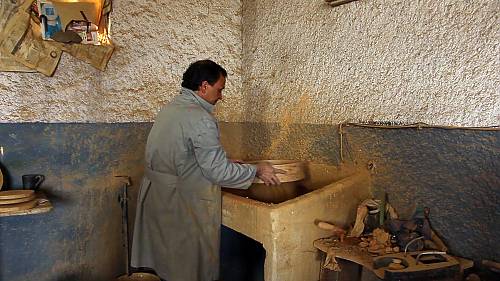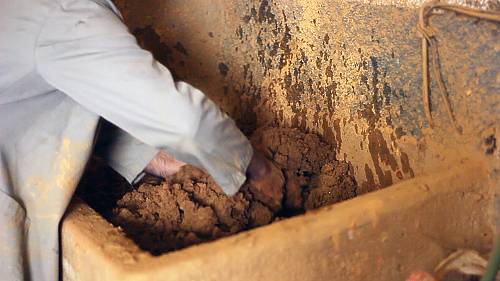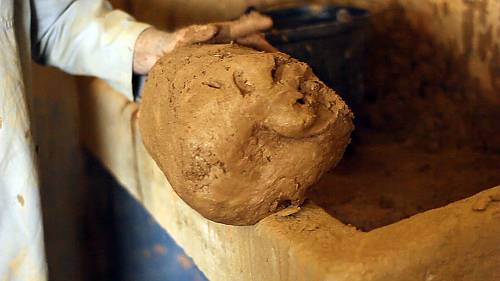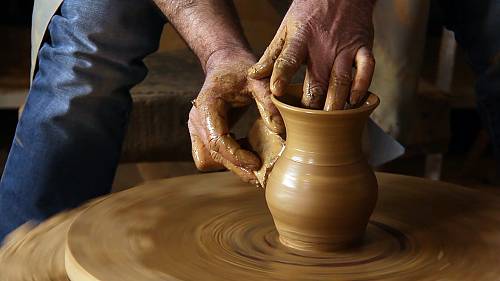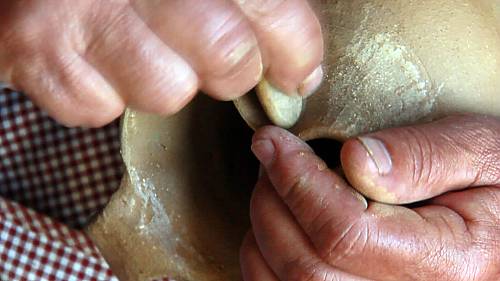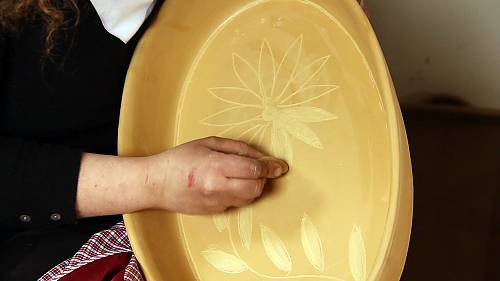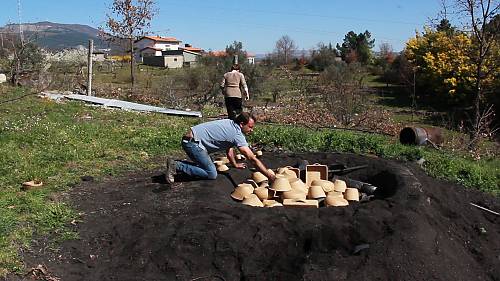Report on the status of an element inscribed on the list of intangible cultural heritage in need of urgent safeguarding
A. Cover sheet
A.1.
State Party
Name of State Party
Portugal
A.2.
Date of deposit of the instrument of ratification, acceptance, approval or accession
This information is available online.
Date of deposit of the instrument of ratification, acceptance, approval or accession
2008-05-21
A.3.
Element inscribed on the Urgent Safeguarding List that is the subject of this report
Name of element
Bisalhães black pottery manufacturing process
Inscribed in
2016
Submitting State(s)
Portugal
A.4.
Reporting period covered by this report
Please indicate the period covered by this report.
Reporting period covered by this report
2016 - 2020
A.5.
Other elements inscribed on the Urgent Safeguarding List, if any
Please list all other elements from your country inscribed on the Urgent Safeguarding List, together with the year of inscription; for multinational elements, please indicate the other States concerned.
Other elements inscribed on the Urgent Safeguarding List, if any
Manufacture of cowbells (2015)
A.6.
Executive summary of the report
Please provide an executive summary of the report that will allow general readers to understand the current status of the element, any positive or negative impacts of inscription, the implementation of safeguarding measures during the reporting period and their possible update for the following years.
Executive summary of the report
The Bisalhães black pottery manufacturing process is at a very delicate stage. In fact, in spite of the positive impact of the inscription at the UNESCO List of Intangible Cultural Heritage in Need of Urgent Safeguarding, the most important problem identified was devastating: in the last years the wife of a potter died – D. Adorinda Martins Sigre – as well as the potter Sezisnando Ramalho, this November. Beside, Potters Manuel Martins and Cesário Martins, have serious health problems and almost stopped working – their production decreased substantially. One of the women (Maria de Fátima da Cunha Macário) that participated actively in the manufacturing process, accompanying the potter Jorge Ramalho, left the village.
On the positive side, lots of activities included in the safeguarding plan were accomplished. An application to European Union funding was approved, and it will allow to implement the most part of the safeguarding plan measures – and others – in the next years.
The inscription at the UNESCO List of Intangible Cultural Heritage in Need of Urgent Safeguarding had a huge impact on the visibility of this artwork and its practitioners. Social media granted good coverage of the tradition and its bearers, and the village was visited by national politic personalities, during national events that took place in Vila Real or nearby. On the negative side, some confusion was made (even among the potters) regarding the funding of the activities preconized in the safeguarding plan. Some people thought that the inscription at the UNESCO list granted some kind of funds to the City Council, therefore misunderstanding its role as main funder of the plan itself.
Finally, it must be highlighted that the two younger potters maintain their activity, as well as the growing interest shown by the community (even if sometimes not understanding the Municipality work and intentions), and the surging of other young designers/practitioners interested in knowing and developing the Bisalhães black pottery tradition.
The implementation of safeguarding measures during the reporting period wasn’t as easy as one could think. The international economic crisis, and its local consequences, forced the City Council to review its priorities, mostly due to the social impact in the community. Nevertheless, The City Council made an effort to find financial EU aid, and successfully applied to a Program for EU funding, that was meant to be implemented this year. But the Covid-19 pandemic forced the suspension of most of the planned activities, that are supposed to take place in the near future.
A.7.
Contact person for correspondence
Provide the name, address and other contact information of the person responsible for correspondence concerning the report.
Title (Ms/Mr, etc.)
Mrs.
Family name
Almeida
Given name
Eugénia Margarida Coutinho da Silva
Institution/position
City Councilor for Culture, Vila Real City Council
Address
Avenida Carvalho Araújo
5000-657 Vila Real
Telephone number
(+351) 259 308 100
E-mail address
eugeniaalmeida@cm-vilareal.pt
Other relevant information
The technician responsible for submitting this report is Mrs. Gina Telmo, Director of the Municipal Museums of Vila Real City Council.
E-mail address - ginatelmo@cm-vilareal.pt
B
Ms
B. Status of element inscribed on the Urgent Safeguarding List
Refer to the nomination file or to previous reports, if any, as the basis for reporting on the current status of the element, and report only on relevant changes since the date of inscription on the List or since the previous report. Nomination files, specific timetables and earlier reports, if any, are available at https://ich.unesco.org or from the Secretariat, upon request.
The State Party shall pay special attention to the role of gender and shall endeavour to ensure the widest possible participation of the communities, groups and, where applicable, individuals concerned as well as relevant non-governmental organizations during the process of preparing this report, and is asked to describe how it has done so in point D below.
B.1.
Social and cultural functions
Please explain the social and cultural functions and meanings of the element today, within and for its community, the characteristics of the bearers and practitioners, and any specific roles or categories of persons with special responsibilities towards the element, among others. Attention should be given to any relevant changes related to inscription criterion U.1 (‘the element constitutes intangible cultural heritage as defined in Article 2 of the Convention’).
Social and cultural functions
Being a potter became a more respected job in Bisalhães and in Vila Real. The potters themselves feel recognized by their community and by the more and more visitors that come to Vila Real, and they are proud identifying themselves as artisans. The biggest problem is the age of most of the potters. Four of them have 80 or more years, and the younger ones are in the forties and fifties. The practice continues to be seen not as a job, but as a hobby, or as a complement to their monthly wages or retirement funds. The personal relationship remains difficult with some of the potters (and between them as well). The women’s roll in the manufacturing process maintains its importance, currently less focused on the hardest part of the clay transformation, and more at the decoration and the kiln preparation.
The intergenerational transmission of know-how, as in many other pottery centres in Portugal, is customarily accomplished almost exclusively within each family. Kinship relations are also important along all the operational chain, which involves collaboration with other members of the potter's family, usually following a division of tasks by gender and generation. However, this gender/age-based division of labour has gradually become blurred, and men now execute tasks that were traditionally performed by women and children, such as the hard work of clay preparation.
B.2.
Assessment of its viability and current risks
Please describe the current level of viability of the element, particularly the frequency and extent of its practice, the strength of traditional modes of transmission, the demographics of practitioners and audiences and its sustainability. Please also identify and describe the threats, if any, to the element's continued transmission and enactment and describe the severity and immediacy of such threats, giving particular attention to any strengthening or weakening of the element’s viability subsequent to inscription.
Assessment of its viability and current risks
The manufacturing process still active in Bisalhães. Querubim Rocha continues to work in his office in Bisalhães, and the same does “the sculptor” Albano Carvalho. Querubim even cleaned up his office, once he felt the crescent look for the potters and their pottery in the village itself. Jorge Ramalho continues to work in a regular basis, and increased his production. The younger potter, Miguel Fontes, also increased his production, as well as his pedagogical performance, in a partnership with the City Council. However, the potter Sezisnando Ramalho passed away, as well as D. Adorinda Sigre, wife of Cesário Martins. He almost stopped working, as his brother Manuel Martins did, since both have serious health problems – their productions substantially decreased.
Some of the younger generations in the potters’ families start to show some interest in learning their relatives’ skills and know-how.
As threats, we can identify the difficulty that the potters from Bisalhães have in accepting new practitioners that don’t come from the village or their families. Even if they organize some workshops (as Jorge Ramalho does), the tradition is kept inside the village. The modernization of some of the processes isn’t well seen by the potters. The electrification of the potters’ wheel isn’t a practice, and the transformation of the clay continues a hard work that some mechanization could ease, but it’s seen as contrary to the ancestral practice and to the inscription in the UNESCO List.
The access to the clay itself is more difficult, nowadays, as the tile factories where the potters went to get it are now closed.
The potters are also afraid of the growing of objects that can be mistaken as Bisalhães pottery, and they don’t usually like to produce new design pieces, if they don’t create them themselves.
B.3.
Implementation of safeguarding measures
Please report on the safeguarding measures described in the nomination file, and previous report, if any. Describe how they have been implemented and how they have substantially contributed to the safeguarding of the element during the reporting period, taking note of external or internal constraints such as limited resources. Include, in particular, information on the measures taken to ensure the viability of the element by enabling the community to continue to practise and transmit it. Include the following detailed information concerning the implementation of the set of safeguarding measures or safeguarding plan:
B.3.a.
Objectives and results
Indicate what primary objective(s) were addressed and what concrete results were attained during the reporting period.
Objectives and results
The safeguarding plan proposed aimed essentially at preventing the disappearance of the knowledge associated with the manufacture of Bisalhães black pottery.
Raising-awareness among younger generations regarding this tradition was also a main objective, as well as creating conditions to improve the economic sustainability of this traditional craft.
Another key objective involves the improvement of the working conditions for the existing potters.
The safeguarding plan is also aimed at strengthening the profitability of this craft, in particular by enhancing awareness of Bisalhães black pottery, regionally, nationally and internationally.
The last four years have been very important for Bisalhães black pottery. Even if some of the activities didn’t took place, there was an investment in the divulgation of the potters and of the pottery. On the other side, Bisalhães black pottery was the theme of many urban art interventions, as well as the subject for studies, academic works and several scientific publications and communications in heritage and handcraft events. Radio and TV shows took place, inviting regional, national and international public to know and visit Vila Real and Bisalhães. The pottery was also included in important tourism routes, such as the National Road N 2, and visits to Bisalhães almost triplicated. The potters’ sale and working points suffered interventions, i.e. new painting and pre-installation of electricity.
After the inscription, and thanks to the new visibility of the element, the demand or pottery increased, the local restaurants invested in presentation with Bisalhães pottery and the majority of regional institutions started to choose Bisalhães pottery trophies, to offer in their activities, following the example of the Vila Real City Council.
B.3.b.
Safeguarding activities
List the key activities that were carried out during this reporting period in order to achieve these expected results. Please describe the activities in detail and note their effectiveness or any problems encountered in implementing them.
Safeguarding activities
The implementation of the safeguarding plan didn’t occur quite as planned initially. In the beginning of 2018 the technician responsible for the Inscription file (and the safeguarding plan) left the City Hall, and the transition to the actual person took some time. The international economic crisis, and its local consequences, forced the City Council to review its priorities, mostly due to the social impact in the community.
Nevertheless, the City Council made an effort to find financial EU aid, and successfully applied to a Program, that was meant to be implemented this year. But the Covid-19 pandemic forced us to stop most of the planned activities that are supposed to take place in 2021 and 2022.
Key activities:
Requalification of the potters’ sale and working places in Vila Real. It was a request of the potters, but after the intervention none of them finished the required installation of the electric panel.
Support to the potters’ participation at “Feira dos Pucarinhos”, building the individual stands and creating information supports. Unfortunately, only two of the potters participate actively, Miguel Fontes and Albano Machado. Trying to diversify the animation and attract different publics, the City Council created the concept “Black Night”, an event that proposes gatherings, dinner and amusement with the focus on the black pottery. The Covid-19 pandemic prevented its concretization, this year.
The Vila Real Museums maintained their prolific activity concerning the Bisalhães pottery, with dozens of workshops (“small potters”) realized, at the Museums or at schools of all the Municipality.
The Municipal Theatre, in partnership with the Bragança Theatre, created an original show, “Clay – wet soil where the boot slips”, with the participation of the community of Vila Real.
The Bisalhães pottery is highlighted in all the National and International Cultural and Tourism Fairs where the City Council participates, such as BTL (Lisbon) and Xantar (Ourense, Spain).
First Edition of the National Encounter on Bisalhães Black Pottery, in the Vila Real Theatre, with the participation of all the community, including some of the potters, that were included in a discussion panel.
In association with the CTT (National Post Office), a series of stamps was created, allusive to the Bisalhães black pottery.
Since 2016, every edition of the “Pitoresco – Street Art and Graffiti Festival” had interventions allusive to Black pottery: a big mural, representing one of the potters; several workshops with young kids, painting previously bought pottery; electrical boxes in public spaces, crossing black pottery with famous artworks (Magritte, for example); exhibitions in different spaces along the city; postcards and photography publication.
Tribute to the Bisalhães potters in a new roundabout in Vila Real, with the creation of a big sculpture representing a traditional jug. Almost all of the potters were there for the opening event.
Bisalhães black pottery was the theme to several communications in national events, in Oporto, Guimarães, Tomar, Vila Real, Macedo de Cavaleiros and Santo Tirso, some of them with the participation of Miguel Fontes, Bisalhães’ potter, with demonstration of his work and report on his knowledge and activity.
Presence in national and international media, in more than 40 TV shows, radio programs and publications (egg. “MorningCalm”, from South Corean Flight Company, or “Know-how of Bisalhães potters is ICH”, Encounter resumes, ed. NEGEP/UNIRIO/CITCEM; Rio de Janeiro).
B.3.c.
Participation of communities, groups or individuals in the safeguarding activities
Describe how communities, groups or, if appropriate, individuals as well as relevant non-governmental organizations have effectively participated, including in terms of gender roles, in the safeguarding measures. Describe the role of the implementing organization or body (name, background, etc.) and the human resources that were available for implementing safeguarding activities.
Participation of communities, groups or individuals in the safeguarding activities
Almost all of the activities were implemented by the Vila Real City Council. The municipal cultural and technical departments had a major leading part, such as the Vila Velha Museum, the Archaeologic and Numismatic Museum, the Public Library, the Municipal Literary Guild and the Municipal Theatre. More than 50 technics were involved in all the processes.
The Local Parishes of Vila Real and Mondrões (that involves Bisalhães village) were also an active part in the implementation of some of the activities.
Cultural local organizations, such as “Covilhete Brotherhood” (“covilhete” is a veal pie, typical from Vila Real, that was originally made in a Bisalhães small pan, called “covilhete”), are City Council’s partners in promoting black pottery and its traditional uses, mostly in culinary.
National Companies, as EDP – Portuguese Energy Company or CTT – Portuguese Post Office participated in the implementation of two important measures, the requalification of the potters’ sale and work points and the national and international divulgation of Bisalhães pottery through stamps.
The organizers of cultural events and the regional and national Artists, by being sensible to the theme and integrating it in their works, for example in the “Pitoresco” Murals, in exhibitions at the Museums and in photography.
Finally, but the most important, the potters and their families, by transmitting their knowledge to their youngers and by participating in Encounters, TV shows and Workshops.
B.3.d.
Timetable
Indicate in a timetable when each activity was implemented.
Timetable
2016-2020 - Requalification of the potters’ sale and working places in Vila Real.
2016-2019 – Support to the potters’ participation at “Feira dos Pucarinhos”. In 2020, because of the pandemic state, it took place in the Archaeologic Museum.
2017-2019 – “Black Night”, an event that proposes gatherings, dinner and amusement with the focus on the black pottery. The Covid-19 pandemic prevented its concretization, tin 2020.
2016-2020 – The Vila Real Museums maintained their prolific activity concerning the Bisalhães pottery, with dozens of workshops (“small potters”) realized, at the Museums or at schools of all the Municipality.
2017 – Original show, “Clay – wet soil where the boot slips”, with the participation of the community of Vila Real.
2016-2020 – The Bisalhães pottery is highlighted in all the National and International Cultural and Tourism Fairs where the City Council participates, such as BTL (Lisbon) and Xantar (Ourense, Spain).
2018.11.29 – First Edition of the National Encounter on Bisalhães Black Pottery, in the Vila Real Theatre.
2018 – In association with the CTT (National Post Office), a series of stamps was created, allusive to the Bisalhães black pottery.
2016-2020 – Every edition of the “Pitoresco – Street Art and Graffiti Festival” had interventions allusive to Black pottery.
2015.05.01 – Tribute to the Bisalhães potters in a new roundabout in Vila Real, followed by the registration in the National Inventory and the announcement of the application to UNESCO.
2017-2019 – Bisalhães black pottery was the theme to several communications in national events.
2016-2020 – Presence in national and international media, in more than 40 TV shows, radio programs and publications.
2016-2020 – Publications, promotional flyers from Bisalhães black pottery.
2019 – Exhibition “Caruma - A look at Bisalhães”, organized by the Vila Velha Museum, under the supervision of Vila Real City Council.
2017-2020 – Acquisition of black pottery by the Vila Real City Council for its collection and for institutional offers.
2016-2017 – Bridge construction between Almodena and Vila Marim, one of the main routes to reach Bisalhães and Mondrões.
2016-2020 – Support the “Covilhete Brotherhood”.
2020 - Bituminous paving of Bisalhães main street (work already assigned, to be done in early 2021).
B.3.e.
Budget expenditures
Provide the detailed amounts of the funds used for the implementation of each activity (if possible, in US dollars), identifying the funding source for each (governmental sources, in-kind community inputs, etc.).
Budget
2016-2020 - Requalification of the potters’ sale and working places in Vila Real. 7096,35€
2016-2019 – Support to the potters’ participation at “Feira dos Pucarinhos”. In 2020, because of the pandemic state, it took place in the Archaeologic Museum.1500€
2017-2019 – “Black Night”, an event that proposes gatherings, dinner and amusement with the focus on the black pottery. The Covid-19 pandemic prevented its concretization, tin 2020. 41.772,5€
2016-2020 – The Vila Real Museums maintained their prolific activity concerning the Bisalhães pottery, with dozens of workshops (“small potters”) realized, at the Museums or at schools of all the Municipality.1730€
2017 – Original show, “Clay – wet soil where the boot slips”, with the participation of the community of Vila Real. 6.860,81€
2016-2020 – The Bisalhães pottery is highlighted in all the National and International Cultural and Tourism Fairs where the City Council participates, such as BTL (Lisbon) and Xantar (Ourense, Spain).4500€
2018.11.29 – First Edition of the National Encounter on Bisalhães Black Pottery, in the Vila Real Theatre. 2035,11€
2018 – In association with the CTT (National Post Office), a series of stamps was created, allusive to the Bisalhães black pottery. 50€
2016-2020 – every edition of the “Pitoresco – Street Art and Graffiti Festival” had interventions allusive to Black pottery. 2500€
2015.05.01 – Tribute to the Bisalhães potters in a new roundabout in Vila Real, followed by the registration in the National Inventory and the announcement of the application to UNESCO. 19.464,85€
2017-2019 – Bisalhães black pottery was the theme to several communications in national events. 500€
2016-2020 – Presence in national and international media, in more than 40 TV shows, radio programs and publications.1889€
2016-2020 – Publications, promotional flyers from Bisalhães black pottery. 2975€
2019 – Exhibition “Caruma - A look at Bisalhães”, organized by the Vila Velha Museum, under the supervision of Vila Real City Council. 2794€
2017-2020 – Acquisition of black pottery by the Vila Real City Council for its collection and for institutional offers. 8.867,18€
2016-2017 – Bridge construction between Almodena and Vila Marim, one of the main routes to reach Bisalhães and Mondrões. 155 000€
2016-2020 – Support the “Covilhete Brotherhood”. 2500€
2020 - Bituminous paving of Bisalhães main street (work already assigned, to be done in early 2021). 45 824,28€.
B.3.f.
Overall effectiveness of the safeguarding activities
Provide an overall assessment of the effectiveness of the activities undertaken to achieve the expected results and of the efficiency of the use of funds for implementing the activities. Please indicate how the activities contributed to achieving the results and whether other activities could have contributed better to achieving the same results. Also indicate whether the same results could have been achieved with less funding, whether the human resources available were appropriate and whether communities, groups and individuals could have been better involved.
Overall effectiveness of the safeguarding activities
The last four years have been very important for Bisalhães black pottery. Even if some of the activities considered in the safeguarding plan didn’t took place, there was an investment in the divulgation of the potters and of the pottery. On the other side, Bisalhães black pottery was the theme to a big number of urban art interventions, as well as subject for studies, academic works and several scientific publications and communications in heritage and handcraft events. Radio and TV shows took place, inviting regional, national and international public to know and visit Vila Real and Bisalhães. The pottery was also included in important tourism routes, such as the National Road N 2, and visits to Bisalhães almost triplicated. The potters’ sale and working points suffered interventions, i.e. new painting and pre-installation of electricity – though the potters didn’t yet terminated the process.
After the inscription, and thanks to the new visibility of the element, the demand of pottery increased, the local restaurants invested in presentation with Bisalhães pottery and the majority of regional institutions started to choose Bisalhães pottery trophies, to offer in their activities, following the example of the City Council.
The safeguarding plan preconized activities in four main areas: Support to practitioners, Training and Education, Economic value and Heritage and Scientific Enhancement. In the first area, the measures weren’t quite effective, as already shown. As for Training and Education: the firs contacts with the Institutions identified was very positive, but the world economic and social context didn’t help to the implementation of the activities proposed, such as the professional training courses for new craftsmen or the inclusion of Bisalhães black pottery in the arts and crafts promotion programmes currently in place. We hope that it can occur in the following years.
Nevertheless, the dissemination and public awareness-raising in the community, particularly among the younger generations in Bisalhães and Vila Real, and the organisation and implementation of training courses and educational activities related to black pottery in municipal museums was a success.
As to the economic value, some of the activities will be implemented in 2021 and 2020, mainly the ones that comprehend physical intervention in Bisalhães and in Vila Real. The Certification of Bisalhães black pottery under the "Arts and Crafts Promotion Programme" and to be used in cooking, must go on in the near future.
Some of the Heritage and Scientific Enhancement area activities took place but were penalized by the economic crisis and by the pandemic state.
C
Telmo
C. Update of the safeguarding measures
C.1.
Updated safeguarding plan
Please provide an update of the safeguarding plan included in the nomination file or in the previous report. In particular provide detailed information as follows:
- a. What primary objective(s) will be addressed and what concrete results will be expected?
- b. What are the key activities to be carried out in order to achieve these expected results? Describe the activities in detail and in their best sequence, addressing their feasibility.
- c. How will the State(s) Party(ies) concerned support the implementation of the updated safeguarding plan?
Updated safeguarding plan
The Vila Real City Council maintains the primary objectives that were established four years ago:
-Preventing the disappearance of the knowledge associated with the manufacture of Bisalhães black pottery;
-Raising-awareness among younger generations regarding this tradition;
-Creating conditions to improve the economic sustainability of this traditional craft;
-Improvement of the working conditions for the existing potters;
-Strengthening the profitability of this craft.
In order to do so, we will execute the Program that was presented and validated to EU financial funding, in a total of approximately 143.000€. Other activities, that are considered important but are not included in that Program, are supposed to encumber the City Council Budget in circa 100.000€.
Key activities:
a) Support to potters in obtaining and transporting the clay from its origin to their workplace;
b) Maintenance of the support given to potters' travel and participation in "Feira dos Pucarinhos" and in other fairs and exhibitions;
c) Professional Training Courses for new craftsmen to be implemented with the collaboration of current practitioners and in partnership with local entities, such as NERVIR (the Vila Real Regional Business Association) and UTAD (University of Trás-os-Montes and Alto Douro);
d) Establishment of a protocol with IEFP - Institute of Employment and Vocational Training to include Bisalhães black pottery in the arts and crafts promotion programmes;
e) Dissemination and public awareness-raising in the community, particularly among the younger generations in Bisalhães and Vila Real;
f) Organisation and implementation of training courses and educational activities related to black pottery in municipal museums;
g) Organisation of activities for children in the city's cultural facilities;
h) Publication and re-printing of editions for young people about Bisalhães black pottery and its associated traditions;
i) Improvement and redesigning of the existing visiting itinerary in the village of Bisalhães, to include all potters’ working places, kilns and shops;
j) Revision of the signage related to the structures in the village of Bisalhães associated with the manufacture of black earthenware;
k) Renovation of the existing signage in the city of Vila Real to better direct visitors to potters’ working shops/stalls and indicate the way to the village of Bisalhães;
l) Certification of Bisalhães black pottery under the "Arts and Crafts Promotion Programme";
m) Certification of Bisalhães black pottery to be used in cooking;
n) Strengthening the promotion of Bisalhães black pottery in Vila Real Tourism Office, by enhancing the information available;
o) Undertaking new temporary and touring exhibitions, and pursuing a plan to publish information about them;
p) Edition and reedition of cultural, ethnographic and tourism publications related to Bisalhães black pottery, aimed at different age levels, with a particular focus on young people and children;
q) Creation of a video and exhibition concerning specifically women’s work and its importance in the manufacturing process;
r) Redesign, update and translation into different languages the existing website about Bisalhães black pottery (http://www.nervir.pt/bisalhaes/) to include updated information about potters and their work and reinforce the site's scientific content, in collaboration with the NERVIR Business Association.
C.2.
Timetable for future actitivies
Provide a timetable for the updated safeguarding plan (within a time-frame of approximately four years).
01065
Timetable
a) Support to potters in obtaining and transporting the clay from its origin to their workplace – 2021-2024;
b) Maintenance of the support given to potters' travel and participation in "Feira dos Pucarinhos" and in other fairs and exhibitions – 2021-2024;
c) Professional Training Courses for new craftsmen to be implemented with the collaboration of current practitioners and in partnership with local entities, such as NERVIR (the Vila Real Regional Business Association) and UTAD (University of Trás-os-Montes and Alto Douro) – 2023;
d) Establishment of a protocol with IEFP - Institute of Employment and Vocational Training to include Bisalhães black pottery in the arts and crafts promotion programmes – 2023;
e) Dissemination and public awareness-raising in the community, particularly among the younger generations in Bisalhães and Vila Real – 2021-2024;
f) Organisation and implementation of training courses and educational activities related to black pottery in municipal museums – 2021-2024;
g) Organisation of activities for children in the city's cultural facilities – 2021-2024;
h) Publication and re-printing of editions for young people about Bisalhães black pottery and its associated traditions – 2021-2022;
i) Improvement and redesigning of the existing visiting itinerary in the village of Bisalhães, to include all potters’ working places, kilns and shops – 2021;
j) Revision of the signage related to the structures in the village of Bisalhães associated with the manufacture of black earthenware – 2021-2024;
k) Renovation of the existing signage in the city of Vila Real to better direct visitors to potters’ working shops/stalls and indicate the way to the village of Bisalhães – 2021;
l) Certification of Bisalhães black pottery under the "Arts and Crafts Promotion Programme" – 2021;
m) Certification of Bisalhães black pottery to be used in cooking – 2021;
n) Strengthening the promotion of Bisalhães black pottery in Vila Real Tourism Office, by enhancing the information available – 2021-2024;
o) Undertaking new temporary and touring exhibitions, and pursuing a plan to publish information about them – 2021-2022;
p) Edition and reedition of cultural, ethnographic and tourism publications related to Bisalhães black pottery, aimed at different age levels, with a particular focus on young people and children – 2021-2024;
q) Creation of a video and exhibition concerning specifically women’s work and its importance in the manufacturing process – 2021;
r) Redesign, update and translation into different languages the existing website about Bisalhães black pottery (http://www.nervir.pt/bisalhaes/) to include updated information about potters and their work and reinforce the site's scientific content, in collaboration with the NERVIR Business Association – 2021-2024.
C.3.
Budget for future activities
Provide the estimates of the funds required for implementing the updated safeguarding plan (if possible, in US dollars), identifying any available resources (governmental sources, in-kind community inputs, etc.).
Budget
In order to implement the present safeguarding plan, the City Council will execute the Program that was presented and validated to EU financial funding, in a total of approximately 143.000€ (EUF). Other activities, that are considered important but are not included in that Program, are supposed to encumber the City Council Budget in circa 100.000€ (VRB). The funds EUF and VRB will be distributed according to the following activities:
a) Support to potters in obtaining and transporting the clay from its origin to their workplace – Vila Real City Council Activity Plan and Budget (VRB)
b) Maintenance of the support given to potters' travel and participation in "Feira dos Pucarinhos" and in other fairs and exhibitions – (VRB)
c) Professional Training Courses for new craftsmen to be implemented with the collaboration of current practitioners and in partnership with local entities, such as NERVIR (the Vila Real Regional Business Association) and UTAD (University of Trás-os-Montes and Alto Douro) – included in the Program presented to EU financial funding (EUF)
d) Establishment of a protocol with IEFP - Institute of Employment and Vocational Training to include Bisalhães black pottery in the arts and crafts promotion programmes – (EUF)
e) Dissemination and public awareness-raising in the community, particularly among the younger generations in Bisalhães and Vila Real – (EUF)
f) Organisation and implementation of training courses and educational activities related to black pottery in municipal museums – (EUF)
g) Organisation of activities for children in the city's cultural facilities – (EUF)
h) Publication and re-printing of editions for young people about Bisalhães black pottery and its associated traditions – (EUF)
i) Improvement and redesigning of the existing visiting itinerary in the village of Bisalhães, to include all potters’ working places, kilns and shops – (EUF)
j) Revision of the signage related to the structures in the village of Bisalhães associated with the manufacture of black earthenware – (EUF)
k) Renovation of the existing signage in the city of Vila Real to better direct visitors to potters’ working shops/stalls and indicate the way to the village of Bisalhães – (EUF)
l) Certification of Bisalhães black pottery under the "Arts and Crafts Promotion Programme" – (EUF)
m) Certification of Bisalhães black pottery to be used in cooking – (EUF)
n) Strengthening the promotion of Bisalhães black pottery in Vila Real Tourism Office, by enhancing the information available – (VRB)
o) Undertaking new temporary and touring exhibitions, and pursuing a plan to publish information about them – (EUF)
p) Edition and reedition of cultural, ethnographic and tourism publications related to Bisalhães black pottery, aimed at different age levels, with a particular focus on young people and children – (EUF)
q) Creation of a video and exhibition concerning specifically women’s work and its importance in the manufacturing process–(EUF)
r) Redesign, update and translation into different languages the existing website about Bisalhães black pottery (http://www.nervir.pt/bisalhaes/) to include updated information about potters and their work and reinforce the site's scientific content, in collaboration with the NERVIR Business Association–(VRB)
C.4.
Community participation
Please describe how communities, groups and individuals, as well as relevant non-governmental organizations have been involved, including in terms of gender roles, in updating the safeguarding plan, and how they will be involved in its implementation.
00179
Community participation
As a result of the concern expressed by the potters and several local institutions about the possible disappearance of this traditional sort of pottery, Vila Real City Council considered that Bisalhães Black Pottery Manufacturing Process would be best safeguarded if recognized both nationally and internationally. Accordingly, it maintained contacts with practitioners and other relevant stakeholders to participate in the implementation of the current safeguarding plan.
Vila Real City Council has also promoted the development of partnerships with several local and regional entities that have made efforts in recent years to preserve Bisalhães pottery. Mondrões and Vila Real Parish Councils, for example, will play active roles in the implementation of several activities among the community and their territory.
NERVIR Association will also be actively involved, thus contributing to the redefinition of the initiatives to be implemented, such as the organisation of new training courses. It has also agreed to reedit existing publications on black pottery, and will redesign Bisalhães pottery website created in 2000.
The University UTAD will become a key partner in safeguarding the tradition. In addition to seeking greater proximity between the potters' activity and the scientific community in the fields of heritage and anthropology, the common goal is to promote further research and the development of projects in several of the courses taught at universities.
C.5.
Institutional context
Please report on the institutional context for the local management and safeguarding of the element inscribed on the Urgent Safeguarding List, including:
- a. the competent body(ies) involved in its management and/or safeguarding;
- b. the organization(s) of the community or group concerned with the element and its safeguarding.
2008-05-21
Institutional context
Safeguarding the Bisalhães black pottery manufacturing process is mainly responsibility of the potters themselves. Although they don’t have an association that represent them, the Vila Real City Council is making an effort on documenting all de process stages, and on creating links between the local community and the craftsmen. The Vila Real City Council tries to connect all the interested parties mainly through the Culture City Council, and technically through the Municipal Museums team, especially its director, Dr. Gina Telmo.
D
Gina
D. Participation of communities in preparing this report
Describe the measures taken to ensure the widest possible participation of the communities, groups and, where applicable, individuals concerned as well as relevant non-governmental organizations during the process of preparing this report.
Participation of communities in preparing this report
For the execution of this report, we took into account the actions/opinions of the various entities that during these four years had a proactive role in the promotion, tourism development and safeguarding of Bisalhães black pottery, because only in this way, it was possible to compile such a high number of activities carried out: various services in Vila Real City Council (Museums, Cultural Services, Infrastructure Division, Municipal Theater, Municipal Library, Literary Guild, Tourism, Education), Mondrões and Vila Real Parish Council, NERVIR, Schools in the Municipality of Vila Real, Turismo de Portugal.
We also took into account the various independent studies and thesies carried out on this theme, which point out strategies so that this ancestral art is not lost and, on the contrary, that it is reinvented and perpetuated over time.
The community of Vila Real and, in particular, Bisalhães (with natural collaboration and commitment of potters and their families), was also considered in terms of their future expectations, desires, apprehensions and dynamics that they intend for their art.
E. Signature on behalf of the State Party
The report should be signed by an official empowered to do so on behalf of the State, and should include his or her name, title and the date of submission.
Name
Rui Jorge Cordeiro Gonçalves dos Santos
Title
The Honourable Mayor of Vila Real
Date
11-12-2020
Signature
Rui Jorge Cordeiro Gonçalves dos Santos
Upload signed version in PDF


